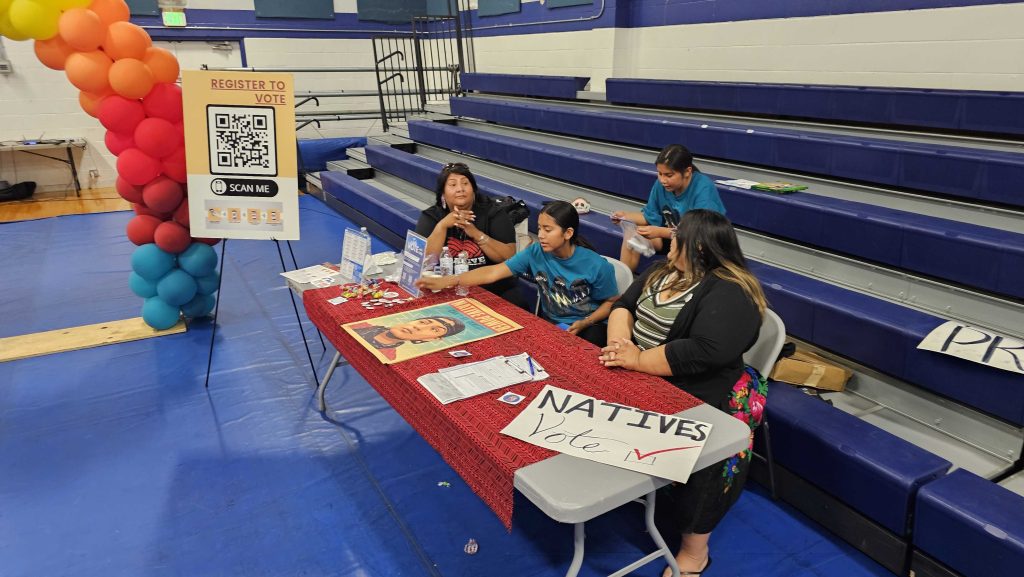Podcast: Play in new window | Download | Embed
Photo: Paul Bolger / KNPR
Tribal members living on reservations and colonies in Nevada are now among the roughly 300,000 Americans who can cast a ballot online.
Nevada Public Radio’s Paul Boger reports.
The Native American Rights Fund estimates that the average turnout among Indigenous voters during the last six election cycles was 37%.
Turnout among white voters averaged around 51%.
One reason is that tribal communities have faced historical and geographic obstacles to casting a ballot, including a lack of polling locations and unreliable mail service.
“It’s one of the day-to-day challenges that you come to accept.”
That’s Brian Mason, Chairman of the Shoshone Paiute Tribes of the Duck Valley Reservation, which straddles the Nevada-Idaho state line.
In previous elections, the nearest polling location was open only on election day, two hours away.
Chairman Mason says a lot of people didn’t get a chance to vote.
“If you couldn’t make it to Elko, you just didn’t go.”
This year, voters living on the Duck Valley Reservation or any of the 27 other tribal communities in the state can vote online using Nevada’s digital Effective Absentee System for Elections (EASE).
The state developed it in 2014 to allow members of the armed forces overseas and others to cast absentee ballots online.
Mathilda Miller is with the Native Voters Alliance of Nevada, one of the organizations that pushed for the expansion.
She says EASE, along with voting by mail, allows Native voters in Nevada to have their voices heard like never before.
“I think it’s a great opportunity, and I think it’s great to see that this voting tool is being extended to our people.”
Opponents of electronic voting have expressed doubts about the EASE system’s security.
For Miller, those concerns are part of an effort to continue disenfranchising Native voters.
“It’s allowing people who have the means and the infrastructure to cast your vote. I’m excited about it, and I’m hoping that that will continue to happen with more years, more elections and more education. More people can take advantage of the system.”
For in-person voting, the Secretary of State’s office says there will be 18 polling locations on tribal land on election day, 12 early voting locations, and eight ballot drop boxes available to Native voters throughout the state.

Montana Conservation Corps (MCC) crews, made up of high school and college students from the Wind River Indian Reservation, help Chicago Botanic Garden interns collect seeds for the Seeds of Success program. (Courtesy BLM Wyoming)
Tribes may soon have support in growing and maintaining traditional plants.
U.S. Rep. Norma Torres (D-CA) has introduced legislation called the Native American Seed Act.
Rep. Torres says, if passed, her bill would allow the U.S. Department of the Interior and tribes to determine and protect seeds important to their members.
“A way for Native Americans to begin to develop their own seed bank based on the agricultural plants that they have traditionally known from their very beginnings.”
Rep. Torres is a member of the Congressional Native American Caucus.
Her legislation was jointly introduced with U.S. Rep. Doug LaMalfa (R-CA).
Rep. Torres says this bipartisan effort began when she visited a tribe in New Mexico which had constructed a modest seed bank.
“Their way of cultivating the goods that we eat is something that we should highlight and we should be very proud of, as Americans. So my bill begins the process to get Native tribes focused on saving their seeds for future generations.”
Movements for food sovereignty and reclaiming traditional plants have picked up steam in the last few years.
Rep. Torres says her bill will help build on that momentum.

(Photo: daveparker via Wikimedia)
A new California bill educating K through 12 schoolchildren on the attempted genocide of Native Americans goes into effect January 1.
The Oregonian reports that Gov. Gavin Newsom (D-CA) signed the bill in September.
The curriculum will educate students on the California native tribes who endured violence oppression, and atrocities during the Spanish colonial period, and the Gold Rush.
Supporters say it also teaches about the resiliency of Native people.
Today’s National Native News was written and anchored by Brian Bull. Antonia Gonzales is on assignment.
Get National Native News delivered to your inbox daily and stay up-to-date on the 2024 Native Vote. Sign up for our daily newsletter today.



